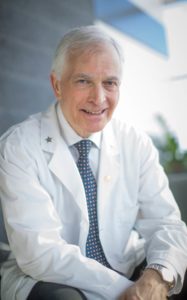Understanding the full spectrum of Parkinson’s disease: A Q&A with Dr. Anthony E. Lang (Part 1)
June 4, 2022

Each year during our Grand Challenges in Parkinson’s Disease symposium, Van Andel Institute presents the Jay Van Andel Award for Outstanding Achievement in Parkinson’s Disease Research to a scientist or scientists whose work is transforming our understanding of Parkinson’s. This year, we’re pleased to honor Anthony E. Lang, O.C., M.D., RCP, FAAN, FCAHS, FRSC. Dr. Lang is one of the most highly cited researchers in the field of movement disorders. His groundbreaking, multifaceted research seeks to understand how movement disorders such as Parkinson’s begin, how they spread in the brain, and how these insights may be translated into the treatments that slow or stop disease progression — a feat not possible with existing therapeutic strategies.
This is the first in a two-part Q&A with Dr. Lang. Today, we’re talking research and how our understanding of Parkinson’s is evolving — and revealing new insights that may spur life-changing treatment strategies.
How has our understanding of Parkinson’s shifted in the past decade?
Dr. Lang: I think our understanding of neurodegenerative diseases in general has shifted to the belief that these disorders are what has been termed “proteinopathies,” which are diseases marked by the accumulation and aggregation of proteins that have changed their function. These are normal proteins that have normal biological functions, but we believe that the misfolding of these proteins, for reasons that aren’t clear, has allowed them to acquire a toxic effect — that is, they become capable of damaging nerve cells or at least contributing to the damage of nerve cells. One protein of special interest in Parkinson’s is called alpha-synuclein.
Why is understanding these proteins important for understanding Parkinson’s?
Dr. Lang: Most people now believe that these proteins are critical to the development of neurodegenerative diseases like Parkinson’s and that they have toxic effects that contribute to disease. Therefore, it is critical to understand how they misfold, how the misfolding contributes to the disease and how the proteins may spread from cell to cell.
Importantly, we also now believe that these abnormal proteins can induce normal proteins to misfold as well. This is called templating — a misfolded protein encounters a normal protein and causes it to change. As a result, you see an acceleration and accumulation of misfolded, abnormal proteins, which contribute to the pace of the disease.
Understanding this process really shifts our thinking about how we might be able to develop treatments that could slow disease progression.
Is it just proteins, or are there other factors at play?
Dr. Lang: We still need to think well beyond proteins. There are many biological functions in cells that fail and that contribute to degeneration and disease. In addition to misfolded proteins, we also may need to address inflammation, the role of supporting cells in the brain, and other factors. It’s very complicated, but we are seeing progress in our understanding.
We often hear about the prodromal, or very early stages, of Parkinson’s as a time that may be key for treatments once they are available. What is prodromal Parkinson’s, and why is it important?
Dr. Lang: The general belief is that all neurodegenerative diseases take decades to develop, which means the underlying processes are at work in the brain many years before people experience clinical symptoms. There are two main features of early disease. First, the disease may be slowly spreading through the brain but has not yet attacked critical structures that would result in symptoms. However, these individuals may experience less specific signs that one may not associate with Parkinson’s, such as constipation or difficulty sleeping. It’s only later when the hallmark signs of tremor or difficulty walking appear that we realize those earlier symptoms were part of the disease.
The second is that the brain has a great deal of capacity to compensate for damage. It may be that a person doesn’t develop movement-related symptoms until they’ve lost 60% or more of the dopamine in their brain. That’s because there are compensatory mechanisms and redundancy in the system that allow people to have substantial damage without any overt symptoms.
How does studying rare neurodegenerative diseases impact what we know about Parkinson’s, or vice versa?
Dr. Lang: First, the role of aging is important in understanding neurodegenerative diseases. That is, what mechanisms in the aging brain fail to allow these diseases to develop? Secondly, there are a lot of commonalities in the degenerative process across diseases. It may be that several diseases have processes in common. For example, inflammation seems to be common in neurodegenerative diseases. Perhaps, then, appropriately designed anti-inflammatory medications may be a viable treatment strategy. Understanding the neurodegenerative process, no matter the disease, helps us learn how to treat and manage all of them more effectively.
What role do genetics play in Parkinson’s and neurodegeneration?
Dr. Lang: There are a small number of cases in which a single malfunctioning gene causes Parkinson’s. In most cases, however, multiple genes and variations within those multiple genes contribute to the disease. Thanks to studies that look at the whole genome — that is, all our genetic material — we now know of at least 90 genes that may contribute to Parkinson’s. A single variation in most of these genes is not enough to cause the disease, but if you have many variations in multiple genes plus exposure to certain environmental factors, that could add up to a high risk.
The two most common genes in Parkinson’s are LRRK2 and GBA. We’re now seeing studies about the proteins made by those genes and how they differentiate subtypes of Parkinson’s. In fact, treatments developed to target Parkinson’s caused by changes in these genes are now being studied in typical Parkinson’s, in which those genes may play a smaller role. That’s exciting.
This year’s Grand Challenges in Parkinson’s Disease scientific symposium and Rallying to the Challenge meeting for people with Parkinson’s, advocates and care partners will be held Sept. 28–29. For more information, please visit grandchallengesinpd.org.